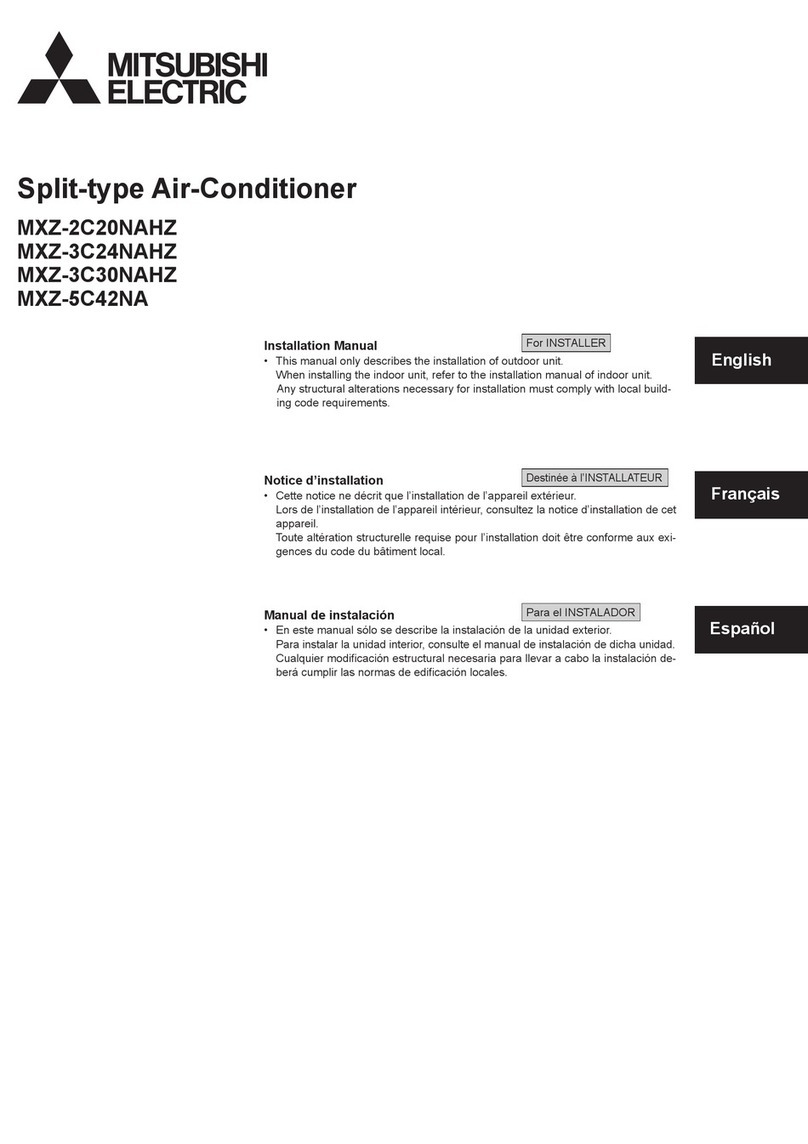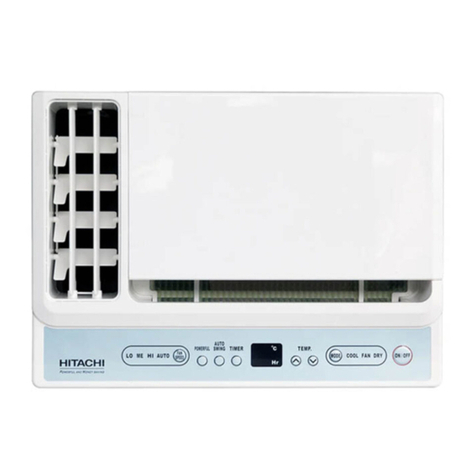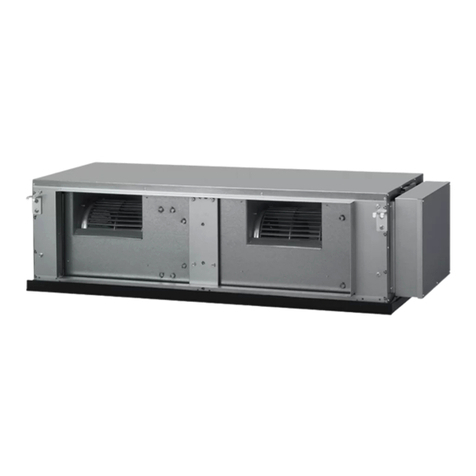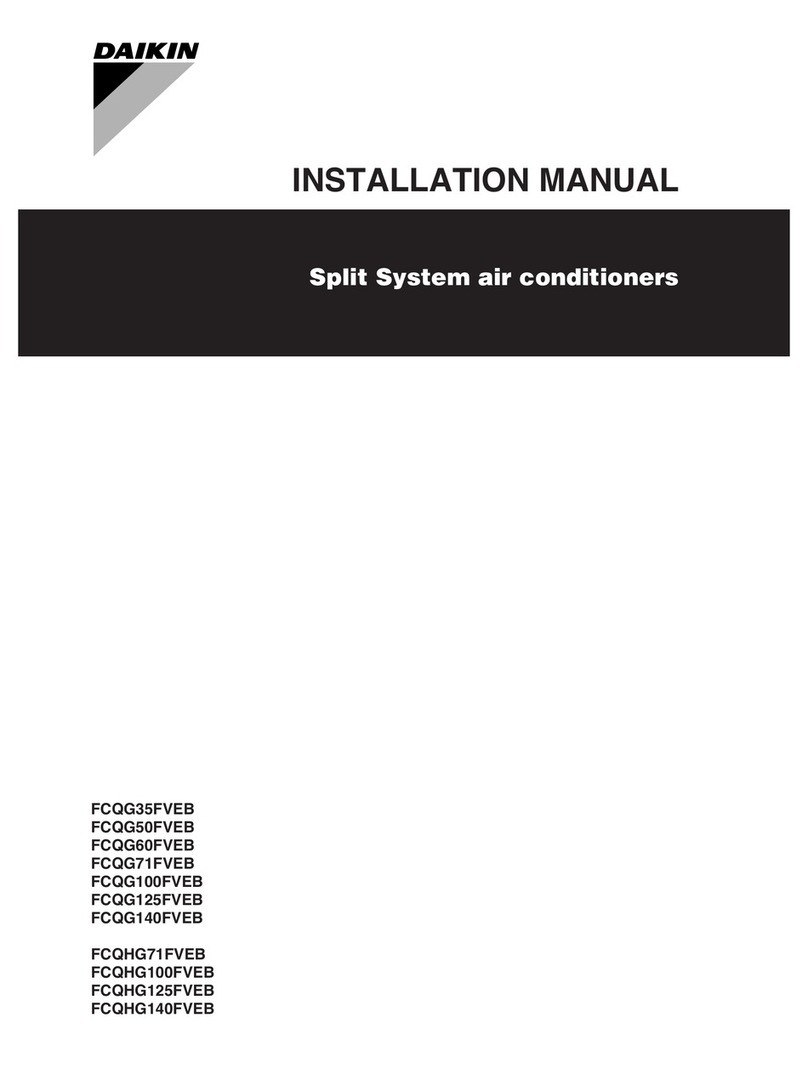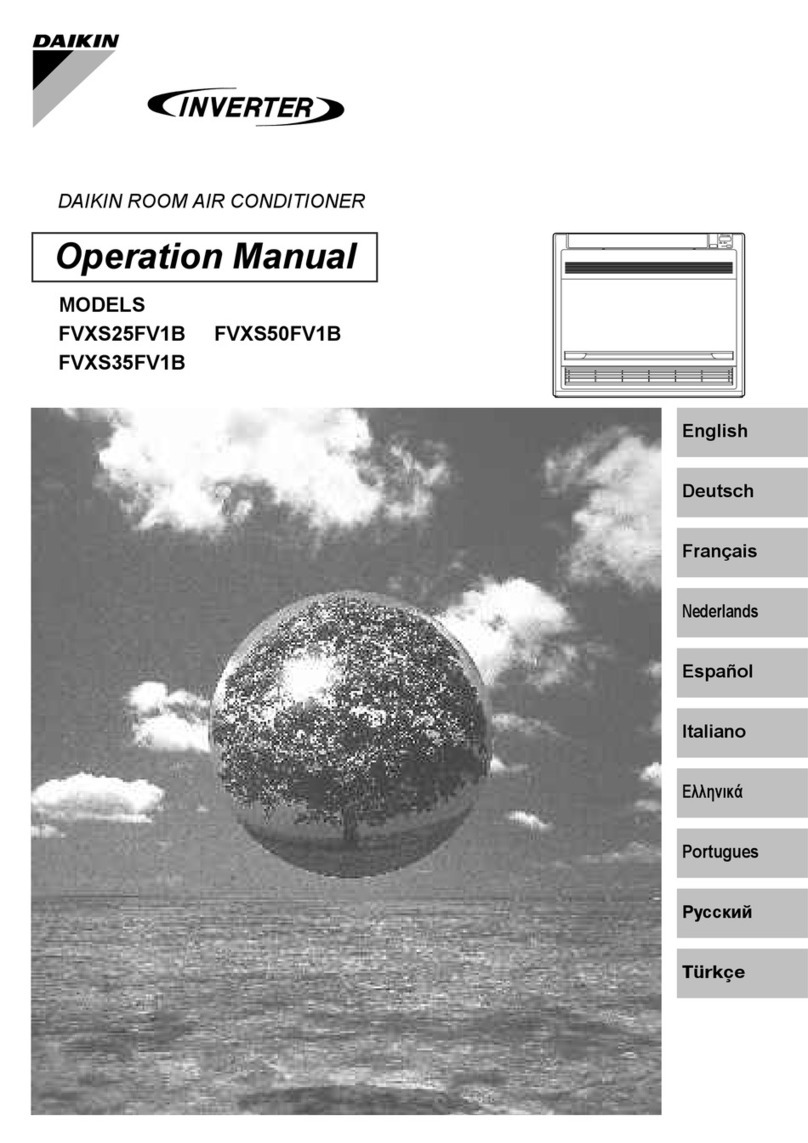BGH BMPE36CTL User manual

1
Modelos:
BMPE36CTL, BMPE60CTL & BMPE72CTL
Manual de usuario e instalación
Unidades interiores
de alta eficiencia
1.5 - 6 TR
Refrigerante R410-A

2
RECOGNIZE THIS SYMBOL AS AN INDICATION
OF IMPORTANT SAFETY
INFORMATIO
DO NOT DESTROY THIS MANUAL
Please read carefully and keep in a safe place for future reference by a serviceman.
is document is customer property and is to remain with this unit.
ese instructions do not cover all the different variations systems nor does it provide
for every possible contingency to be met in connection with installtion.
All phases of this installation must comply with NATIONAL STATE AND LOCAL CODES.
If additional information is required please contact your local distributor.
ese instructions are intended as an aid to qualified
licensed service personnel for proper installation, adjustment
and operation of this unit. Read these instructions
thoroughly before attempting installation or operation.
Failure to follow these instruction may result in improper
installation,adjustment, service or maintenance possibly
resulting in fire, electrical shock, property damage,
personal injury or death.

3
Safety
General
2.1 Unit dimensions
Applications
3.1 Vertical upflow
3.2 Vertical downflow
3.3 Horizontal
3.4 Installation in an unconditioned space
Electrical wiring
4.1 Power wiring
4.2 Control wiring
4.3 Grounding
4.4 Electrical data
Airflow performance
Ductwork
Refrigerant connections
7.1 Condensate drain tubing
Air filter (not factory-installed)
Filter installation dimensions
Wire diagram
Table of contents
04
08
09
10
10
10
12
13
14
14
14
15
15
16
18
19
19
21
22
23
1
2
3
4
5
6
7
8
9
10

4
1. Safety
is is a safety alert symbol. When you see this symbol on labels or in manuals,
be alert to the potential for personal injury.
is is an attention alert symbol. When you see this symbol on labels or in manuals,
be alert to the potential for personal injury.
Disconnect all power to unit before installing or servicing. More than one disconnect switch
may be required to de-energize the equipment. Hazardous voltage can cause server personal
injury or death.
If removal of the blower assembly is required, all disconnect switches supplying power to the
equipment must be de-energized and locked (if not in sight of unit ) so the field power wires
can be safely removed from the blower assembly. Failure to do so can cause electrical shock
resulting in personal injuring or death.
Because of possible damage to equipment or personal injury, installation, service, and
maintenance should be performed by a trained, qualified service personnel. Consumer service
is recommended only for filter cleaning / replacement. Never operate the unit with the acess
panels removed.
ese instructions are intended as an aid to qualified, licensed service personnel for proper
installation, adjustment and operation of this unit. Read these instructions thoroughly before
attempting installation or operation.
failure to follow these instructions may result in improper installation, adjustment, service or
maintenance possibly resulting in fire, electrical shock, property damage, personal injury or
death.

5
Decide the correct way of conveying the equipment.
Try to transport this equipment with the original package.
If the air conditioner needs to be installed on a metal part of the building, electric insulation
must be performed, and the installation must meet the relevant technical standards of
electric devices.
e appliance shall not be installed in the laundry.
Before obtaining access to terminals, all supply circuits must be disconnected.
e appliance must be positioned so that the plug is accessible.
e enclosure of the appliance shall be marked by word, or by symbols, with the direction of
the fluid flow.
e appliance shall be installed in accordance with national wiring regulations If the supply
cord is damaged, it must be replaced by the manufacture or its service agent or a similarly
qualified person in order to avoid a hazard.
An all-pole disconnection switch having a contact separation of at least 3mm in all poles
should be connected in fixed wiring.
e temperature of refrigerant circuit will be high, please keep the interconnection cable away
from the copper tube.
is appliance can be used by children aged from 8 years and above and persons with reduced
physical, sensory or mental capabilities or lack of experience and knowledge if they have been
given supervision or instruction concerning use of the appliance in a safe way and understand
the hazards involved. Children shall not play with the appliance. Cleaning and user maintenance
shall not be made by children without supervision。
Install the unit where the air inlet and air outlet are free from obstacles and strong wind.
Install the unit in a dry and well ventilated place.
Install the unit where the bearing surface is level and can bear weight of the unit, and is
suitable for installing the unit horizontally without increasing noise or vibration.
Install the unit where the operation noise and the expelling of air do not affect neighbors.
Install the unit where no flammable gas is leaked.
Install the unit where it is convenient for pipe connection and electric connection.

6
DISPOSAL: Do not dispose this product as unsorted municipal waste.
Collection of such waste separately for special treatment is necessary.
Do not dispose of electrical appliances as unsorted municipal waste, use separate collection
facilities.
Contact you local government for information regarding the collection systemsavailable.
If electrical appliances are disposed of in landfills or dumps, hazardous substances can leak
into the groundwater and get into the food chain, damaging your health and well-being.
e unit must be permanently grounded. Failure to do so can result in electrical shock causing
personal injury or death.
PROPOSITION 65: is appliance contains fiberglass insulation. Respirable particles of
fiberglass are known to State of California to cause cancer.
All manufacturer products meet current federal OSHA Guidelines for safety.
California Proposition 65 warnings are required for certain products, which are not covered by
the OSHA standards.
California’s Proposition 65 requires warnings for products sold in California that contain or
produce any of over 600 listed chemicals known to the State of California to cause cancer
or birth defects such as fiberglass insulation, lead in brass, and combustion products from
natural gas.
All “new equipment” shipped for sale in California will have labels stating that the product
contains and /or produces Proposition 65 chemicals. Althoughwe have not changed our
processes, having the same label on all ourproductd facilitates manufacturing and shipping.
We cannot always know“when, or if” products will be sold in the California market.
You may receive inquiries from customers about chemicals found in, or produced by, some
of our heating and air-conditioning equipment, or found in natural gas used with some of our
products. Listed below are those chemicals and substances commonly associated with similar
equipment in our industry and other manufacturers.

7
Glass Wool (Fiberglass) Insulation
Carbon Monoxide (CO).
Formaldehyde
Benzene
More details are available at the websites for OSHA (Occupational Safety and Health
Administration), at www.osha.gov and the State of California’s OEHHA (Office of
Environmental Health Hazard Assessment), at www.oehha.org. Consumer education is
important since the chemicals and substances on the list are found in our daily lives.
Most consumers are aware that products present safety and health risks, when improperly
used, handled and maintained.
Make sure the blower motor support is tight (3-motor mount
bolts) then check to see if wheel is secured to motor shaft
before operating unit.
BLOWER MOTOR SHIPPING BOLT
e first 36 inches of supply air plenum and ductwork must be constructed of sheet metal as
required by NFPA 90B. e supply air plenum or duct must have a solid sheet metal bottom
directly under the unit with no openings, registers or flexible air ducts located in it. If flexible
supply air ducts are used they may be located only in the vertical walls of rectangular plenum,
a minimum of 6 inches from the solid bottom. Metal plenum of duct may be connected to the
combustible floor base, if not, it must be connected to the unit supply duct exposed to the
supply air opening from the downflow unit.
Exposing combustible (non-metal) material to the supply opening of a downflow unit can
cause a fire resulting in property damage, personal injury or death.
Exception warning to downflow:
Installations on concrete floor slab with supply air plenum and ductwork completely encased
must be not less than 2 inches of concrete (See NFPA 90A).

8
2. General
e unit can be positioned for bottom return air in the upflow position, left and right return in
the horizontal position, top return in downflow position.
is Air Handler provides the flexibility for installation in any upflow or downflow horizontal
application. e direct drive motors provides a selection of air volume to match any
application. 3-Speed motors provide selections of air flow to meet desired applications.
Top and side power and control wiring, accessible screw terminals for control wiring all
combine to make the installation easy, and minimize installation cost. Please contact your local
distributor. See fig.1.
For ensure the proper installation, Select the enough solid and level site.
Ensure enough space required for installation and maintenance.
Top view of the outdoor unit (multiple units installed).

9
2.1 Unit dimensions
Dimension data
Note: 25º clearance is required in the front
of the unit for filter an coil mantenance.
Fig 1 Dimensions
Electrical conections may exit top
or either side.
24
36
60
72
Dimensions inch [mm]
UNIT HEIGHT
“H” IN. [mm]
MODEL
SIZE
UNIT WIDTH
“W” IN.[mm]
UNIT LENGHT
“D” IN.[mm]
SUPPLY
DUCT “A”
UNIT WEIGHT/
SHIPPING WEIGHT
(LBS.[kg])
41-3/8”[1050]
46-1/2”[1180]
54-1/2”[1385]
54-1/2”[1385]
18-1/8”[ 460]
19-5/8”[500]
22”[560]
22”[560]
20-1/2”[520]
20-5/8”[550]
24”[610]
24”[610]
16”[406]
18”[456]
19-1/2”[496]
19-1/2”[496]
106/119 [48]/[54]
141/156 [64]/[71]
171/187 [78]/[85]
171/187 [78]/[85]

10
3. Applications
3.1 Vertical Upflow
• Vertical Upflow configuration is the factory set on all models (see Fig 1).
• If a side return air opening is required, field fabricate a return air plenum with an opening
large enough to supply unit and strong enough to support unit weight.
• If return air is to be ducted, install duct flush with floor. Use fireproof resilient gasket 1/8 to
1/4 in. thick between the ducts, unit and floor. Set unit on floor over opening.
IMPORTANT NOTE
Torque applied to drain connections should not exceed 15.ft.lbs.(see Fig.1&2)
3.2 Vertical Downflow
Conversion to Vertical Downflow: A vertical upflow unit may be converted to the
vertical downflow on it. Remove the door and indoor coil and reinstall 180° from
original position. See Fig. 2~3.
Fig2 Dimensions for
front connect coil

11
IMPORTANT
To comply with certification agencies and the National Electric Code for horizontal right
application, the circuit breaker(s) on field-installed electric heater kits must be re-installed per
procedure below so that the breaker switch “on” position and marking is up and, “off” position
and marking is down.
• To rotate breaker(s): Rotate one breaker set (circuit) at a time starting with the one on the
right. Loosen both lugs on the load side of the breaker. (Make sure that wires are identified and
are reinstalled into proper breaker).Wires are bundles with wire ties, one bundle going to the
right lug and one bundle going to the left lug.
• Using a screwdriver or pencil, lift blue plastic tab with hole away from breaker until breaker
releases from mounting opening.
• With breaker held in hand, rotate breaker so that “on” position is up, “off” position is down
with unit in planned vertical mounting position. insert right wire bundle into top right breaker
lug, ensuring all strands of all wires are inserted fully into lug, and no wire insulation is in lug.
• Tighten lug as tight as possible while holding circuit breaker. Check wires and make sure each
wire is secure and none are loose. Repeat for left wire bundle in left top circuit breaker lug.
• Replace breaker by inserting breaker mounting tab opposite white pull tab in opening, hook
mounting tab over edge in opening.
• With screwdriver or pencil, pull blue tab with hole away from breaker while setting that side
of breaker into opening. When breaker is in place, release tab, locking circuit breaker into
location in opening.
• Repeat above operation for remaining breaker(s) (if more than one is provided).
• Replace single point wiring jumper bar, if it is used, on line side of breaker and tighten
securely.
• Double check wires and lugs to make sure all are secure and tight. Check to make sure unit
wiring to circuit breaker load lugs match that shown on the unit wiring diagram.
When using the unit with electrical heater, the switch is used only for electrical heater on the
front of panel.

12
3.3 Horizontal
Horizontal right is the default factory configuration for the units.
Horizontal left isn’t the default factory configuration for the units.
Conversion to Horizontal: A vertical upflow unit may be converted to horizontal right
by removing indoor coil assembly and reinstalling coil as shown for right hand air supply.
And reinstall coil in unit as shown for right hand air supply.
• Rotate unit into the downflow position, with the coil compartment on top and the blower
compartment on bottom. See Fig. 3.
• Reinstall the indoor coil 180° from original position. Ensure the retaining channel is fully
engaged with the coil rail. See Fig. 3.
• Secondary drain pan kits are required when the unit is configured for the horizontal right
position over a finished ceiling and/or living space.
Fig3 Vertical downflow & horizontal left applications
(lower front service panel removed “view”.)

13
Fig4 Indoor coil and drain pan set-up
Horizontal units must be configured for right hand air supply or left hand air supply. Horizontal
drain pan must be located under indoor coil. Failure to use the drain pan can result in property
damage.
Conversion in Horizontal Direction: Horizontal left-hand supply can be changed to horizontal
right-hand supply by removing the indoor coil and reinstalling 180° from original.
3.4 Installation in an unconditioned space
IMPORTANT
ere are two pairs of coil rails in the air handler for default and counter flow application. If the
air handler is installed in an unconditioned space, the two unused coil rails should be removed
to minimize air handler surface sweating. e coil rails can be easily removed by taking off the
6 mounting screws from both sides of the cabinet.

14
4.1 Power wiring
It is important that proper electrical power is available for connection to the unit model being
installed. See the unit nameplate, wiring diagram and electrical data in the installation
instructions. e power cord type designation is H05RN-R/H07RN-F.
• If required, install a branch circuit disconnect of adequate size, located within sight of, and
readily accessible to the unit.
• IMPORTANT
After the Electric Heater is installed, units may be equipped with one, two, or three 30/60 amp.
circuit breakers. ese breaker(s) protect the internal wiring in the event of a short circuit and serve
as a disconnect. Circuit breakers installed within the unit do not provide over-current protection of
the supply wiring and therefore may be sized larger than the branch circuit protection.
• Supply circuit power wiring must be 75°C minimum copper conductors only. See Electrical
Data In this section for ampacity, wire size and circuit protector require ment. Supply circuit
protective devices may be either fuses or “HACR” type circuit breakers.
• Power wiring may be connected to either the right, left side or top. ree 7/8”, 1-3/8”, 1-3/4”
dia. concentric knockouts are provided for connection of power wiring to unit.
• Power wiring is connected to the power terminal block in unit electric cabinet.
4.2 Control wiring
IMPORTANT
Class 2 low voltage control wiring should not be run in conduit with main power wiring and
must be separated from power wiring, unless class 1 wire of proper voltage rating is used.
• Low voltage control wiring should be 18 Awg. color-coded. For lengths longer than 100 ft., 16
Awg. wire should be used.
4. Electrical wiring
Field wiring must comply with the National Electric Code (C.E.C. in Canada) and any applicable
local ordinance.
Disconnect all power to unit before installing or servicing. More than one disconnect switch
may be required to de-energize the equipment. Hazardous voltage can cause severe personal
injury or death.

15
• Grounding may be accomplished by grounding metal conduit when installed in accord ance
with electrical codes to the unit cabinet.
• Grounding may also be accomplished by attaching ground wire(s) to ground lug(s) provided in
the unit wiring compartment.
• Ground lug(s) are located close to wire entrance on left side of unit (up-flow).
Lug(s) may be moved to marked locations near wire entrance on right side of unit (upflow). If
alternate location is more convenient.
• Use of multiple supply circuits require grounding of each circuit to lug(s) provided in unit.
4.3 Grounding
• Low voltage control connections are made to low voltage pigtails extending from top of air
handler (upflow position - see Figure 3). Connections for control wiring are made with wire
nuts. Control wiring knockouts (518 and 7/8) are also provided on the right and left side of the
unit for side connection.
• See wiring diagrams attached to indoor and outdoor sections to be connected.
• Make sure, after installation, separation of control wiring and power wiring has been
maintained.
e unit must be permanently grounded. FaIlure to do so can result In electrical shock causing
personal injury or death.
4.4 Electrical data
2
3
5
6
VOLTAGE
NOMINAL
COOLING
COOLING
& HEATING
HERTZ RPM SPEEDSHP CIRCUIT
AMPS
MIN. CIRCUIT
AMPACITY
MAX. CIRCUIT
VOLTAGE HERTZ
220-240
220-240
220-240
220-240
50
50
50
50
701
794
845
963
0.6
1.4
3.3
4.3
1.0
1.8
4.1
5.4
15(A)
15(A)
15(A)
15(A)
3
3
3
3
1/5
1/2
3/4
3/4

16
5. Electrical wiring
Airflow performance data is based on cooling performance with a coil and no filter in place.
Select performance table for appropriate unit size external static applied to unit allows
operation within the minimum and maximum limits shown in table below for both cooling
and electric heat operation.
24
36
NUMBER
MODEL
MOTOR
SPEED
External Static Pressure-Inches W.C.[kPa]
CFM(Watts)
0
[0]
0.1
[.02]
0.16
[.04]
0.2
[.05]
0.3
[.07]
0.4
[.10]
0.5
[.12]
0.6
[.15]
0.7
[.17]
0.8
[.20]
LOW
LOW
MIDDLE
MIDDLE
HIGH
HIGH
CFM
RPM
Watts
Amps
CFM
RPM
Watts
Amps
CFM
RPM
Watts
Amps
CFM
RPM
Watts
Amps
CFM
RPM
Watts
Amps
CFM
RPM
Watts
Amps
695
585
153
0.71
844
680
178
0.81
935
760
220
1.00
1261
755
290
1.32
1394
815
304
1.39
1484
860
352
1.6
658
644
146
0.68
804
723
172
0.78
901
790
214
0.98
1186
778
277
1.26
1311
833
293
1.33
1403
873
341
1.54
618
688
139
0.65
761
759
166
0.76
853
815
208
0.95
1114
801
264
1.21
1229
851
282
1.28
1315
885
328
1.49
606
700
137
0.65
749
768
164
0.75
839
821
205
0.94
1039
819
254
1.16
1158
865
271
1.23
1245
895
319
1.45
560
756
130
0.62
679
813
154
0.71
760
852
194
0.90
1022
824
251
1.15
1142
869
270
1.22
1220
898
315
1.38
490
802
120
0.59
620
858
147
0.69
691
881
184
0.86
919
827
236
1.08
1033
887
257
1.17
1123
910
303
1.38
392
853
109
0.55
516
900
137
0.64
583
913
171
0.81
798
860
216
1.00
902
905
241
1.10
988
923
228
1.04
242
920
92
0.49
359
950
123
0.59
456
935
159
0.76
527
883
182
0.86
630
923
210
0.95
685
944
250
1.14
-
-
-
-
-
-
-
-
169
980
133
0.65
280
938
157
0.75
362
950
182
0.84
420
955
222
1.01
-
-
-
-
-
-
-
-
-
-
-
-
-
-
-
-
-
-
-
-
243
970
208
0.95

17
60
72
NUMBER
MODEL
MOTOR
SPEED
External Static Pressure-Inches W.C.[kPa]
CFM(Watts)
0
[0]
0.1
[.02]
0.16
[.04]
0.2
[.05]
0.3
[.07]
0.4
[.10]
0.5
[.12]
0.6
[.15]
0.7
[.17]
0.8
[.20]
LOW
LOW
MIDDLE
MIDDLE
HIGH
HIGH
CFM
RPM
Watts
Amps
CFM
RPM
Watts
Amps
CFM
RPM
Watts
Amps
CFM
RPM
Watts
Amps
CFM
RPM
Watts
Amps
CFM
RPM
Watts
Amps
1571
742
639
2.93
1696
796
708
3.26
1966
907
941
4.33
1571
742
639
2.93
1696
796
708
3.26
1966
907
941
4.33
1537
784
630
2.88
1642
835
700
3.2
1941
976
904
4.12
1537
784
630
2.88
1642
835
700
3.2
1941
976
904
4.12
1493
819
616
2.82
1593
869
689
3.14
1901
974
885
4.02
1493
819
616
2.82
1593
869
689
3.14
1901
974
885
4.02
1460
850
610
2.78
1550
893
680
3.11
1865
994
873
3.98
1460
850
610
2.78
1550
893
680
3.11
1865
994
873
3.98
1451
859
608
2.78
1545
900
679
3.1
1856
999
871
3.97
1451
859
608
2.78
1545
900
679
3.1
1856
999
871
3.97
1407
890
596
2.72
1491
932
666
3.04
1810
1025
855
3.9
1407
890
596
2.72
1491
932
666
3.04
1810
1025
855
3.9
1351
926
571
2.65
1440
961
653
2.99
1760
1048
836
3.81
1351
926
581
2.65
1440
961
653
2.99
1760
1048
836
3.81
1274
962
568
2.59
1362
996
635
2.9
1707
1070
818
3.72
1274
962
568
2.59
1362
996
635
2.9
1707
1070
818
3.72
1208
994
553
2.52
1301
1024
619
2.82
1644
1094
793
3.62
1208
994
553
2.52
1301
1024
619
2.82
1644
1094
793
3.62
1136
1022
538
2.45
1238
1053
601
2.74
1571
1117
768
3.49
1136
1022
538
2.45
1238
1063
601
2.74
1571
1117
768
3.49

18
e air distribution system has the greatest effect on airflow. e duct system is totally
controlled by the contractor. For this reason, the contractor should use only industry-recognized
procedures.
Heat pump systems require a specified airflow. Each ton of cooling requires between 350 and
450 cubic feet of air per minute (CFM), or 400 CFM nominally.
Duct design and construction should be carefully done. System performance can be lowered
dramatically through bad planning or workmanship.
Air supply diffusers must be selected and located carefully. ey must be sized and positoined
to deliver treated air along the perimerter of the space. If they are too small for their intended
airflow, they become noisy. If they are not located properly, they cause drafts. Reture air grilles
must be properly sized to carry air back to the blower.If they are too small, they also cause noise.
e installers should balance the air distribution system to ensure proper quiet airflow to all
rooms in the home. is ensures a comfortable living space.
An air velocity meter or airflow hood can give a reading of system CFM.
6. Ductwork
Field ductwork must comply with the National Fire Protection Association NFPA 90A, NFPA 90B
and any applicable local ordinance.
Do not, under any circumstances, connect return ductwork to any other heat producing device
such as fireplace insert, stove, etc. Unauthorized use of such devices may result in fire, carbon
monoxide poisoning, explosion, personal injury or property damage.
Sheet metal ductwork run in unconditioned spaces must be insulated and covered with a
vapor barrier. Fibrous ductwork may be used if constructed and installed in accordance with
SMACNA Construction Standard on Fibrous Glass Ducts. Ductwork must comply with National
Fire Protection Association as tested by U/L Standard 181for Class I Air Ducts. Check local
codes for requirements on ductwork and insulation.
• Duct system must be designed within the range of external static pressure the unit is designed
to operate against. It is important that the system airflow be adequate.
Make sure supply and return ductwork, grills, special filters, accessories, etc. are accounted
for in total resistance. See airflow performance tables in this manual.

19
• Design the duct system in accordance with “ACCA” Manual “0” Design for Residential Winter
and Summer Air Conditioning and Equipment Selection. Latest editions are available from:
“ACCA” Air Conditioning Contractors of America, 1513 16th Street, N.W., Washington, D.C.
20036. If duct system incorporates flexible air duct, be sure pressure drop Information (straight
length plus all turns) shown in “ACCA” Manual “D” is accounted for in system.
• Supply plenum is attached to the 3/4” duct flanges supplied with the unit. Attach flanges
around the blower outlet.
IMPORTANT
If an elbow is included in the plenum close to the unit, it must not be smaller than the
dimensions of the supply duct flange on the unit.
IMPORTANT
e front flange on the return duct if connected to the blower casing must not be screwed into
the area where the power wiring is located. Drills or sharp screw points can damage insulation
on wires located inside unit.
• Secure the supply and return ductwork to the unit flanges, using proper fasteners for the type
of duct used and tape the duct-to-unit joint as required to prevent air leaks.
7. Refrigerant connections
Keep the coil connections sealed until refrigerant connections are made. See the Installation
Instructions for the outdoor unit for details on line sizing, tubing installation, and charging
information.
Coil is shipped with “No charge”. Evacuate the system before charging with refrigerant. Install
refrigerant tubing so that it does not block service access to the front of the unit.
Nitrogen should flow through the refrigerant lines while brazing.
Use a brazing shield to protect the cabinet’s paint and a wet rag to protect the rubber grommet
from being damaged by torch flames. After the refrigerant connections are made, seal the gap
around the connections with pressure sensitive gasket.
7.1 Condensate drain tubing
Consult local codes for specific requirements.

20
IMPORTANT
1. When making drain fitting connections to the drain pan, use a thin layer of Teflon paste,
silicone or Teflon tape and install, hand tighten.
2. When making drain fitting connections to drain pan, do not overtighten. Over tightening
fittings can split pipe connetions on the drain pan.
• Install drain lines so they do not block service access to front of the unit. Minimum clearance
of 24 inches is required for filter, coil or blower removal and service access.
• Make sure unit is level or pitched slightly toward primary drain connection so that water will
drain completely from the pan. (See Fig. 5)
• Do not reduce drain line size less than connection size provided on condensate drain pan.
• All drain lines must be pitched downward away from the unit a minimum of 1/8” per foot of
line to ensure proper drainage.
• Do not connect condensate drain line to a closed or open sewer pipe. Run condensate to an
open drain or run line to a safe outdoor area.
Fig5 Condensate drain trap
This manual suits for next models
2
Table of contents
Other BGH Air Conditioner manuals
Popular Air Conditioner manuals by other brands
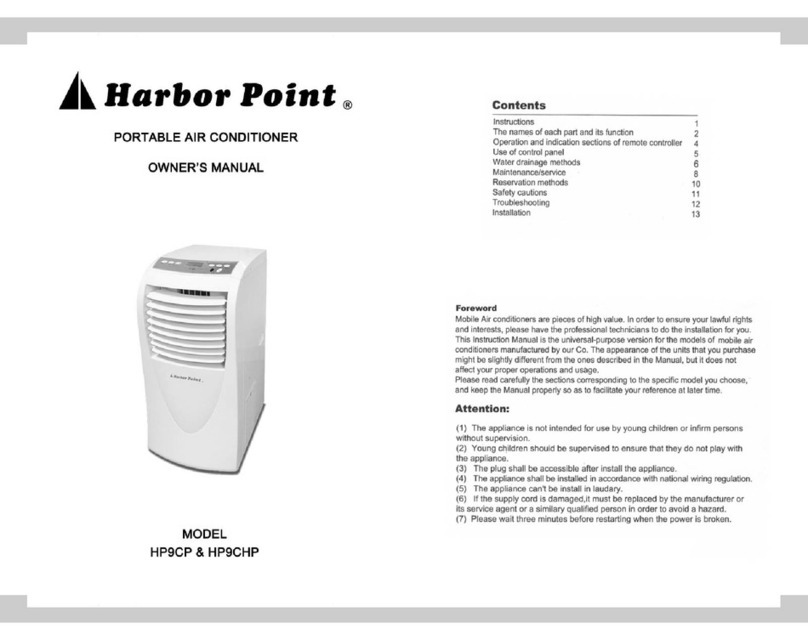
Harbor Point
Harbor Point HP9CP owner's manual

Haier
Haier AW-YHDM009-H91 installation manual
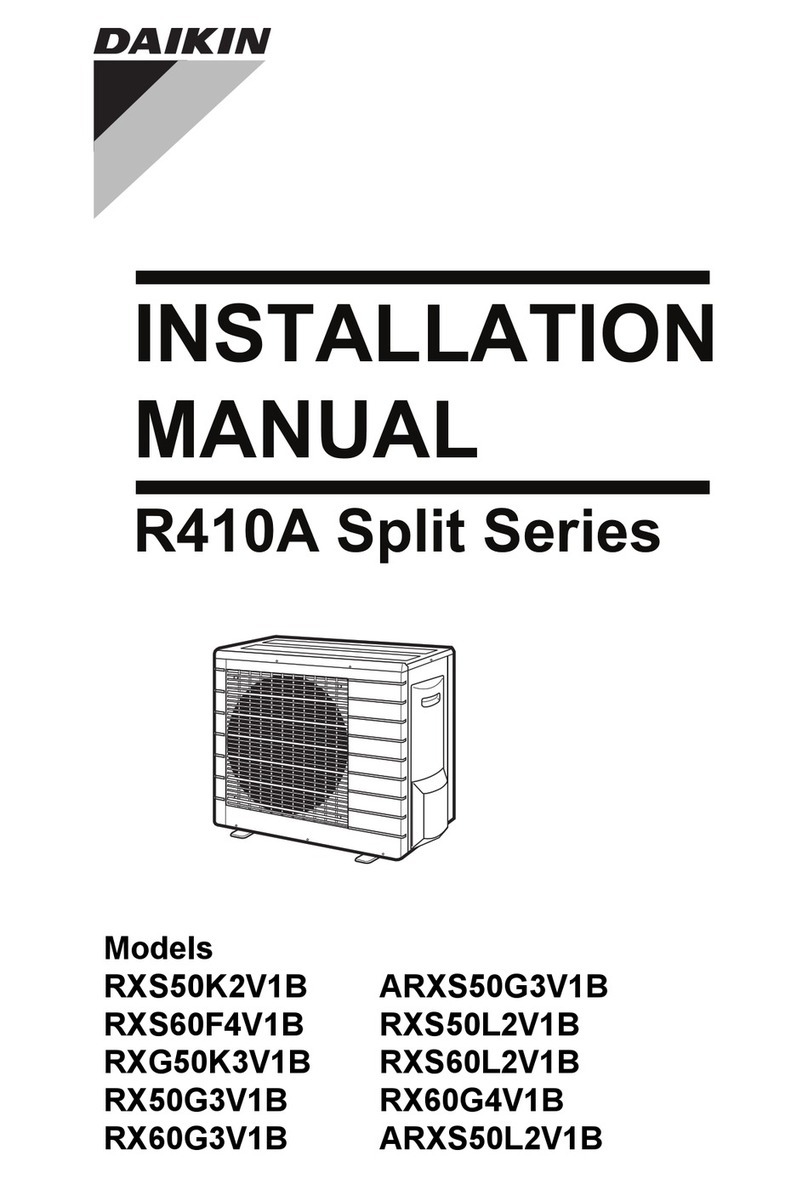
Daikin
Daikin RXS50K2V1B installation manual

Panasonic
Panasonic S-60PU1R5 operating instructions
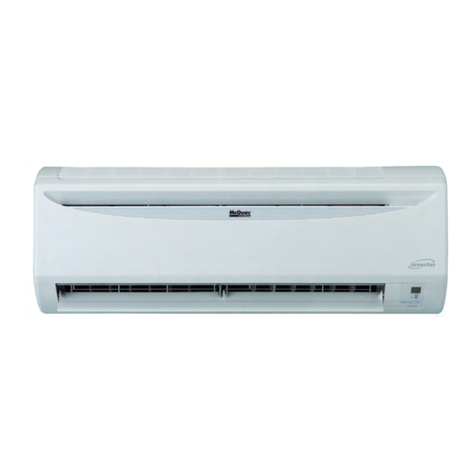
McQuay
McQuay M5WMY10KR installation manual

Mitsubishi Electric
Mitsubishi Electric Mr.SLIM PUMY-P125VKM Service manual
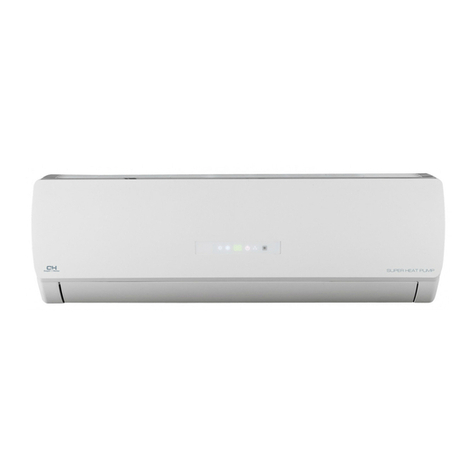
Cooper & Hunter
Cooper & Hunter CH-S09FTXTB2S-W Service manual

dirna Bergstrom
dirna Bergstrom TRP SLIMCOOL User handbook

Hitachi
Hitachi RAM-70NP4B Service manual

Fintek
Fintek WINDY 3 HP instruction manual
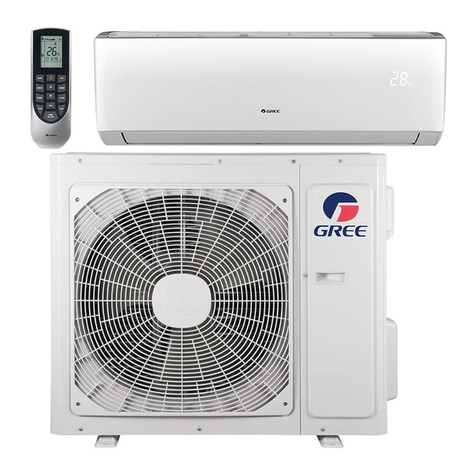
Gree
Gree VIREO+ VIR18HP230V1B Service manual
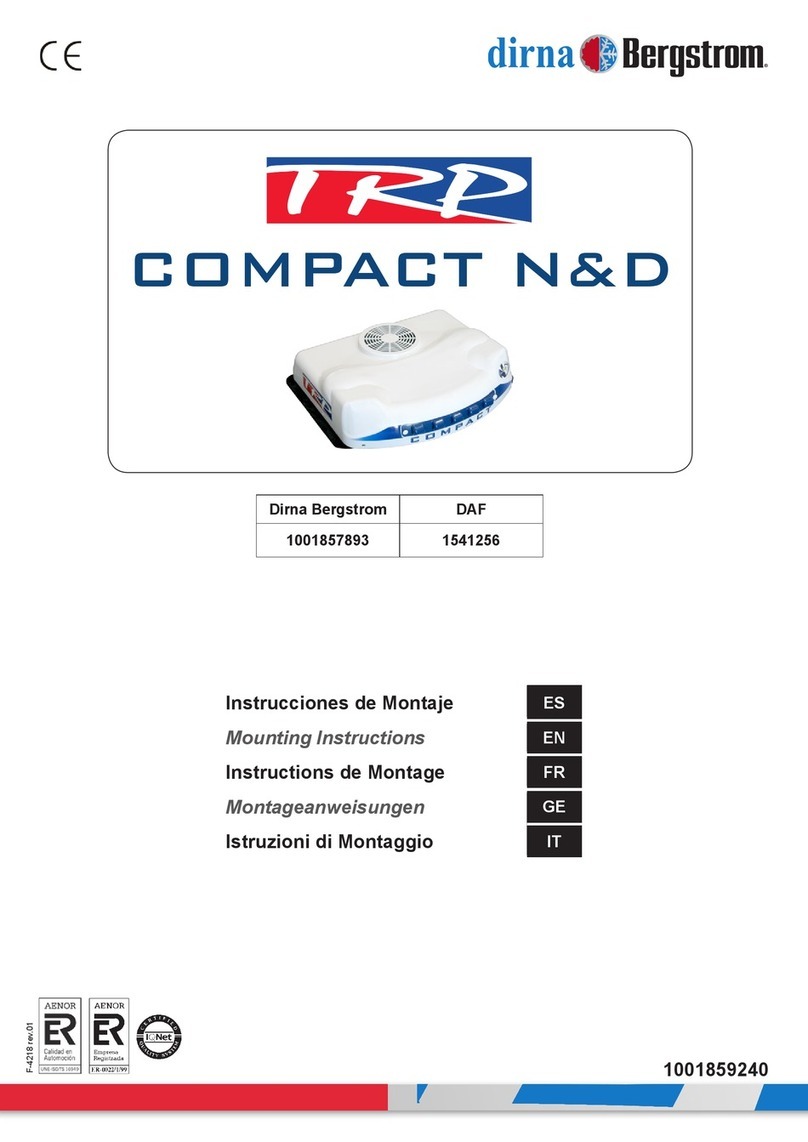
dirna Bergstrom
dirna Bergstrom COMPACT N&D Mounting instructions





